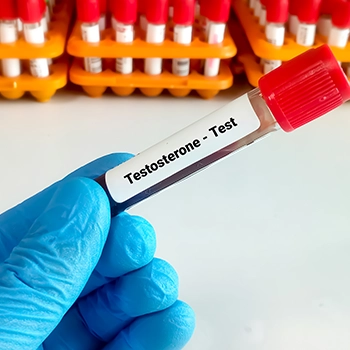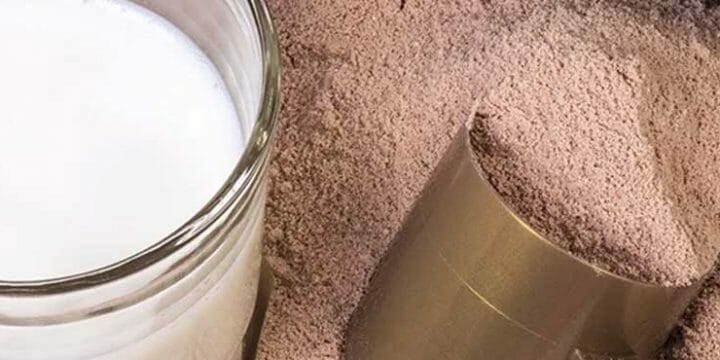In a recent podcast I listened to, an expert mentioned some alarming facts about globally declining testosterone levels.
He said that the average total male testosterone now is 250, having dropped 1% point every year in the past 40.
Being aware of the importance of testosterone as a strength and performance coach, I decided to dig into these studies and statistical data analysis to verify the average amount of testosterone a ‘modern’ man produces daily.
I also discussed these worrying trends with my physician for some additional insight.
These are our findings.
Quick Summary
- The daily testosterone production varies between 3-10 mg in healthy males.
- Low testosterone levels can lead to various factors, ranging from low sex drive, to mood swings, and muscle loss.
- After hitting 30, men's testosterone levels start to decline at about 1% per year.
- In my professional opinion, regular health check-ups and proactive lifestyle changes are essential for managing testosterone levels effectively.
How Much Testosterone Does Man Produce Daily?

A man produces between 3-10 milligrams of testosterone daily, but on average, healthy young men produce around 6 mg of testosterone each day, as reported by Havard Medical School [1].
This amount is secreted primarily by the testes, specifically Leydig cells in testes tissue.
Nevertheless, these numbers may differ depending on measurement methods and the subject’s age.
In addition, dietary choices can significantly impact these levels. For instance, diets rich in zinc and vitamin D have been linked to higher testosterone production.
Measurement Methods
Generally speaking, since testosterone circulates the body through the bloodstream, levels are determined via a blood test. However, the amount is measured in different ways.
In the UK, for example, testosterone level is measured in picomoles per liter (pmol/L) for free testosterone (unbound and available for your body to use) or in nanomoles per liter (nmol/L) for circulating testosterone levels (total testosterone in your blood).
Testosterone levels higher than 225 pmol/L or 12 nmol/L are considered normal.
In the US, free testosterone is measured in ng/dL, with a healthy range of 264-914 ng/dL as per the Journal of Clinical Endocrinology and Metabolism [2].
Significantly higher levels don't necessarily correlate with increased health benefits.
Levels Change With Age

Testosterone levels peak in the late teenage years and remain high until the 30s, then typically decline about 1% annually, a trend I've observed in clients in their early 30s.
On average, it should look like this:
- T-levels in 40s: 252 - 916 ng/dL
- T-levels in 50s: 215 - 878 ng/dL
- T-levels in 60s: 196 - 859 ng/dL
- T-levels in 70s: 156 - 819 ng/dL
If these typical testosterone levels are disturbed during a particular phase of life (and that seems to be a plague of modern men), various symptoms may arise, lowering the quality of life.
What Symptoms Occur When Production Is Below Normal?

As a health & performance coach, I've witnessed the varied impacts of low testosterone in men.
These symptoms affect not just physical aspects like muscle strength and fertility, they also influence psychological effects such as mood and cognition.
It underscores testosterone's role in overall health, including heart and cognitive functions, as highlighted by the National Institutes of Health [3].
“Testosterone deficiency is a very specific clinical condition that is defined by the presence of a set of specific signs and symptoms that occur as a result of decreased production of testosterone by the testes in men.”
- Shalendar Bhasin, MD & Professor of Medicine in Harvard Medical School
According to the Urology Care Foundation, these health problems don’t happen overnight, so you should be continuously mindful of some common symptoms of lower testosterone levels [4].
They may include:
- Depression, memory loss, irritability
- Fatigue and sleep issues
- Loss of facial hair
- Loss of body hair
- More fragile skin
- Erectile dysfunction and loss of sex drive
- Brittle bones and decrease in muscle mass
Even though these symptoms are linked to low testosterone levels, you might experience them even if your levels are above the normal range.
However, you should be able to feel the difference in your general well-being.
Luckily, there are ways to boost testosterone levels and possibly avoid the symptoms that come with the low T.
How to Fix Low Production?

To naturally fix low testosterone production, I always advise my clients to incorporate healthy habits. For example, one of my clients significantly improved his testosterone levels through a combination of strength training, a nutrient-rich diet, and natural supplements.
For most men, low testosterone is nothing but a result of bad lifestyle choices like smoking, lack of activity, constant stress, and a poor diet high in processed foods.
When you change these habits, your testosterone levels will naturally start to recuperate.
Let’s get into the most effective natural ways to achieve this.
1. Exercise
In my opinion, exercise is still the cheapest and most potent medicine out there, and it will help you balance your hormones, including testosterone.
It does this in two ways:
- Aerobic exercises - These will help you lose fat. Knowing that adipose tissue converts testosterone into estrogen (female sex hormone), the equation is straightforward - less fat means more testosterone.
- Weight lifting - Particularly heavy lifting. Compound movements are critical - bench presses, shoulder presses, bodyweight squats, and deadlifts. Studies by the Scandinavian Journal of Medicine and Science in Sports show that this activation of large muscle groups increases testosterone levels [5].
In my experience, to reap the most from exercise, rest for a minute or two between sets, avoid taking each set to failure, and go for high volume. Don’t overtrain and generally move more.
2. Avoid Testosterone Lowering Chemicals

Unfortunately, nowadays, it’s hard to avoid certain chemicals (‘endocrine disruptors’) that interfere with our body’s hormone system and contribute to various health issues.
The most relevant endocrine disruptor for this topic is a chemical called ‘xenoestrogen’.
Xenoestrogen imitates estrogen in the human body and thereby contributes to a significant T levels drop.
It’s present in many things - gasoline, toothpaste, shampoos, pesticides, and plastics.
To minimize your contact with this chemical, do the following:
- Avoid unnecessary exposure to gasoline and pesticides
- Store food in glassware
- Don’t heat food in plastic containers
- Reduce exposure to BPA
- Try to eat organic as much as possible
Check out this article about the common chemicals that lower testosterone.
3. Use Supplements
Another challenge of the modern world is nutrient-poor food and insufficient sun exposure.
Therefore, you might want to include some nutritional supplementations to help you on your journey to optimal T levels.
The most effective ones are:
- Vitamin D3 - Studies by Hormone and Metabolic Research suggest that this supplement could improve T production [6]. How many IU (international units) is adequate for you depends on your sun exposure, but I recommend going between 3000 and 4000 IU.
- Omega 3 Fish Oil - This oil may can help you increase semen volume and total sperm count, traits linked with higher testosterone levels as shown by research published on JAMA Network [7].
- Natural T-booster - These supplements support natural testosterone production with various science-backed herbs and nutrients. They also don’t cause side effects typical for anabolic steroids (increased body and facial hair, kidney problems, hypertension, etc.).
But, if the modern world doesn’t allow you to change your habits entirely, you might be able to bolster your natural production with some of the testosterone boosters for men we found most effective during our in-depth testing.
If nothing helps, check with your GP if your low T levels might be due to some underlying health condition like liver disease, kidney disease, or diabetes.
Some cases might demand certain testosterone treatments, such as testosterone replacement therapy (TRT).
FAQs
How Long Does It Take to Increase Testosterone?
It takes around 4-6 weeks of testosterone replacement therapy (Testosterone-Cypionate, Enanthate, or Propionate) to start feeling the improvement in symptoms.
However, changes like muscle mass growth may take up to 6 months. Increasing testosterone through natural interventions may take longer, but it won’t wreak havoc on your health.
What Time of Day Is a Man’s Testosterone Lowest?
Man’s testosterone levels tend to be lowest around 8 p.m., with a tendency to climb at night. The peak is measured around 8 a.m. and fluctuates throughout the day. That’s why testosterone blood work is done in the morning when free testosterone levels are highest.
References:
- https://www.health.harvard.edu/newsletter_article/testosterone_aging_and_the_mind
- https://academic.oup.com/jcem/article/102/4/1161/2884621
- https://www.ncbi.nlm.nih.gov/pmc/articles/PMC5512682/
- https://www.urologyhealth.org/urology-a-z/l/low-testosterone
- https://onlinelibrary.wiley.com/doi/10.1034/j.1600-0838.2001.110606.x
- https://www.thieme-connect.de/products/ejournals/abstract/10.1055/s-0030-1269854
- https://jamanetwork.com/journals/jamanetworkopen/fullarticle/2758861
About The Author
You May Also Like






